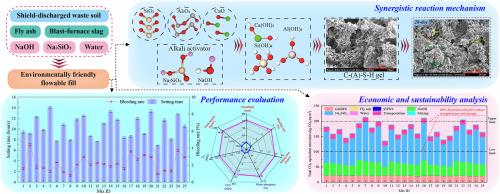绿色创新:将盾构排放的废土和工业固体废物清洁转化为环保的高性能流动填料
IF 5.8
2区 化学
Q2 CHEMISTRY, MULTIDISCIPLINARY
引用次数: 0
摘要
针对传统填料资源消耗高、环境负担大的问题,采用NaOH-Na2SiO3复合材料活化盾构排放废土(SDWS)、磨粒高炉矿渣(GGBFS)和粉煤灰为主要原料,研究了一种环保型流动填料。通过微观结构分析、性能测试和生命周期评估(LCA),系统地评估了所开发材料的反应机理、工程性能、环境影响和经济可行性。结果表明:制备的可流动填料具有良好的工作性和力学性能,初始流动性为602 ~ 755 mm, 28天抗压强度为6.43 ~ 8.98 MPa。骨料比和碱当量对抗压强度的影响比液固比和活化剂模量的影响更显著。微观结构分析表明,GGBFS与粉煤灰在碱活化作用下协同形成致密的C-S-H和C-A-S-H凝胶,提高了材料的性能。LCA结果表明,流动填料的二氧化碳当量(CO2-eq)排放量为136 ~ 214 kg CO2-eq/m3,生态强度效率(ESE)为0.038 ~ 0.053 MPa/(kg CO2-eq·m−3),累积能量需求(CED)为1095 ~ 1537 MJ/m3。ESE和CED指标都优于传统的高强度普通硅酸盐水泥基控制低强度材料(clsm)。原材料成本为224-307元/m3,使用SDWS进一步降低成本。本研究为流动填料提供了创新和可持续的解决方案,支持建筑业的绿色转型和可持续发展。本文章由计算机程序翻译,如有差异,请以英文原文为准。

Green innovation: Clean conversion of shield-discharged waste soil and industrial solid waste into environmentally friendly high-performance flowable fill
To address the high resource consumption and environmental burden of traditional fill materials, this study presents an environmentally friendly flowable fill using shield-discharged waste soil (SDWS), ground granulated blast-furnace slag (GGBFS), and fly ash as the main raw materials activated by a NaOH–Na2SiO3 composite. Microstructural analysis, performance testing, and life cycle assessment (LCA) were conducted to systematically evaluate the reaction mechanisms, engineering properties, environmental impacts, and economic viability of the developed material. The results show that the prepared flowable fill has excellent workability and mechanical properties, with an initial flowability of 602–755 mm and a 28-day compressive strength of 6.43–8.98 MPa. The aggregate-to-binder ratio and alkali equivalent exert a more significant effect on the compressive strength than the liquid-to-solid ratio and activator modulus do. Microstructural analysis indicates that GGBFS and fly ash, under alkali activation, synergistically form dense C–S–H and C–A–S–H gels, improving the properties of the material. The LCA results reveal that the flowable fill achieves carbon dioxide equivalent (CO2-eq) emissions of 136–214 kg CO2-eq/m3, an eco-strength efficiency (ESE) of 0.038–0.053 MPa/(kg CO2-eq·m−3), and a cumulative energy demand (CED) of 1095–1537 MJ/m3. Both the ESE and CED metrics outperform those of conventional high-strength ordinary Portland cement-based controlled low-strength materials (CLSMs). The raw material cost is 224–307 CNY/m3, and the use of SDWS further reduces costs. This study provides an innovative and sustainable solution for flowable fill, supporting the green transformation and sustainable development of the construction industry.
求助全文
通过发布文献求助,成功后即可免费获取论文全文。
去求助
来源期刊

Sustainable Chemistry and Pharmacy
Environmental Science-Pollution
CiteScore
8.20
自引率
6.70%
发文量
274
审稿时长
37 days
期刊介绍:
Sustainable Chemistry and Pharmacy publishes research that is related to chemistry, pharmacy and sustainability science in a forward oriented manner. It provides a unique forum for the publication of innovative research on the intersection and overlap of chemistry and pharmacy on the one hand and sustainability on the other hand. This includes contributions related to increasing sustainability of chemistry and pharmaceutical science and industries itself as well as their products in relation to the contribution of these to sustainability itself. As an interdisciplinary and transdisciplinary journal it addresses all sustainability related issues along the life cycle of chemical and pharmaceutical products form resource related topics until the end of life of products. This includes not only natural science based approaches and issues but also from humanities, social science and economics as far as they are dealing with sustainability related to chemistry and pharmacy. Sustainable Chemistry and Pharmacy aims at bridging between disciplines as well as developing and developed countries.
 求助内容:
求助内容: 应助结果提醒方式:
应助结果提醒方式:


